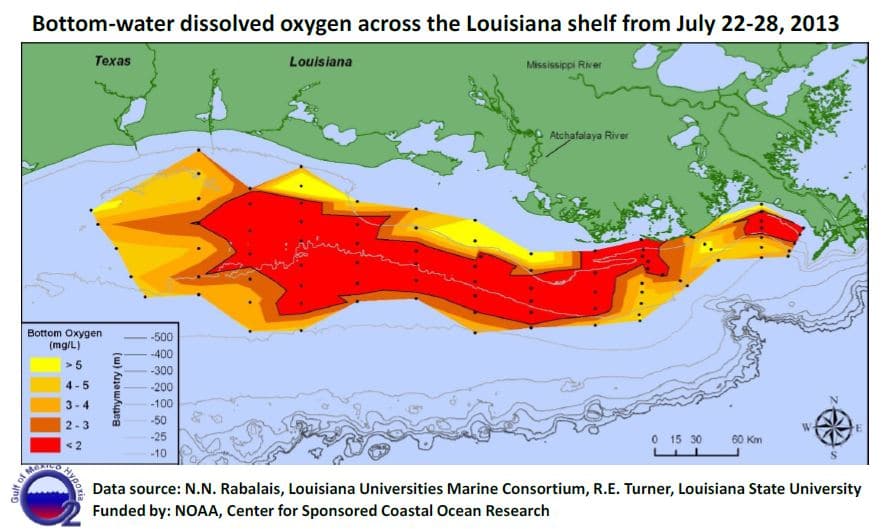Today, Prairie Rivers Network and other members of the Mississippi River Collaborative issued news releases about the size of the 2013 Gulf of Mexico Dead Zone. Please see our news release below and contact Stacy James (217-344-2371) if you have any questions.
Connecticut-Sized 2013 Gulf “Dead Zone” Signifies the Need for Cleaner Water in Illinois
CHAMPAIGN, IL — Yesterday, scientists from the Louisiana Universities Marine Consortium completed their annual measurement of the Gulf of Mexico’s Dead Zone, which measured 5,800 square miles, larger than the state of Connecticut.
The Dead Zone is an area of water at the mouth of the Mississippi River that is oxygen-deprived due to algal blooms fueled by nitrogen and phosphorus pollution. Relatively immobile species like crab and shrimp cannot survive the low oxygen conditions. Over 70% of the pollution comes from working farms and ranches and Illinois is one of the top contributing states. This year’s rainy spring saw above-average amounts of fertilizer draining out of the Midwest and down the Mississippi River.
“Unfortunately, the Midwest is a very leaky system and we all pay the price,” according to Dr. Stacy James, Water Resources Scientist at Prairie Rivers Network.
In addition to causing the Dead Zone in the Gulf, nitrogen and phosphorus pollution degrades thousands of rivers and lakes in the states that drain into the Mississippi River. Symptoms include nuisance algal blooms, which can ruin recreational areas and pose public health risks.
“Too often we think of the Dead Zone as a problem in the Gulf, instead of thinking about how the same pollutants that are causing the Dead Zone there are leading to dangerous algal blooms and economic losses here in Illinois,” said Jessica Dexter, staff attorney with the Environmental Law & Policy Center, a member of the Mississippi River Collaborative. “This is a watershed-wide issue and communities throughout the watershed are being impacted.”
Of particular concern are harmful algal blooms that produce toxins. If present at high enough concentrations, these toxins can harm people, dogs, and aquatic species. When present in lakes that supply drinking water, the blooms can give the water a musty taste and increase treatment costs. Among the producers of toxins are blue-green algae, which can form green, floating scums on the surface of still water. In 2012, four out of ten lakes monitored by the Illinois Environmental Protection Agency and U.S. Geological Survey had toxin concentrations that posed a high probability for adverse health effects (see report at http://www.epa.state.il.us/water/algal-bloom/monitoring.html).
The current “corn rush” plays a major role in the Dead Zone and local algae problems. Illinois corn fields are fertilized with over 2 billion pounds of nitrogen and almost 1 billion pounds of phosphate, according to U.S. Department of Agriculture statistics. Leaky farm fields can shed more than 15% of the nitrogen applied. Researchers at the University of Illinois have found that tile drainage is an important conduit for this loss. In contrast, phosphorus losses are frequently associated with erosion.
Unfortunately, the over fifteen-year effort to reduce the Dead Zone has been fairly anemic. Most states, including Illinois, have resisted adopting limits on the amount of nitrogen and phosphorus that is allowable in rivers. Farmers, who are exempt from the federal Clean Water Act, have been encouraged to voluntarily adopt practices that will reduce fertilizer pollution. But with high corn prices, it does not appear we can rely solely on a sense of shared responsibility to care for the natural world.
The pending 2013 federal Farm Bill provides the most immediate opportunity to clean up the Dead Zone and state waters. Members of the House and Senate could close a significant loophole in farm law that exempts farmers who receive federal crop insurance subsidies from having to preserve land and water resources. It is essential for politicians to realize that conservation is compatible with a strong national economy that depends on clean water. If our national leaders do not act, the Dead Zone has little chance of growing smaller anytime soon.
Data from the Louisiana Universities Marine Consortium Dead Zone cruise can be found at http://www.gulfhypoxia.net/Research/Shelfwide%20Cruises/2013/PressRelease2013.pdf.
Prairie Rivers Network is Illinois’ statewide river conservation organization and the state affiliate of the National Wildlife Federation. Information about Prairie Rivers Network and Farm Bill posts can be found online at www.prairierivers.org.
###








